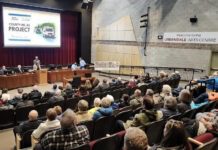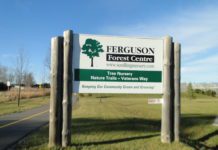submitted by Kenneth Mews
The North Grenville Heritage Symposium, held at the Municipal Centre on April 15, mixed images of bleak losses of culturally significant heritage across the province and hints of the bright future we might have if we looked after our heritage better.
One of the outstanding speakers invited by the North Grenville Municipal Heritage Advisory Committee, sponsors of the event, was Dr. John C. Carter, an historian and chair of the South Bruce Peninsula Municipal Heritage Advisory Committee, who has a passion for barns. He began his presentation by ripping off his shirt to reveal his “Barn Again” T-shirt, a token of his fanatical devotion to saving what have been called “the cathedrals of the fields.” Up and down every country road these awesome old structures, raised by the back-breaking efforts of whole communities of farmers and farm labourers, are rapidly crumbling away from neglect, battered by windstorms and, even worse, stripped by vandals or sold to American speculators. Here today, gone tomorrow.
Government regulation plays a role, too. The need for traditional barns is fast disappearing as small dairy operations wind down. There is no financial assistance available for farmers who are willing but unable to maintain their obsolete barns. Barns can be demolished without a permit. Protecting barns with a heritage designation is very difficult.
And the huge variety of Ontario barns connect us to our agricultural roots—from the small round-log shelter that first served the original settlers as a house, was converted to accommodate their animals, then moved and tacked onto a larger barn. The variety of later barns is startling. They may be a round, eight-sided, sixteen-sided; plain or with fancy carved embellishments and cupolas; German-style with an overhanging forebay or shaped like Noah’s Ark, frame-built or of stone, or even brick.
As Joni Mitchell’s song tells us, “Don’t it always seem to go / That you don’t know what you’ve got / Till it’s gone. / They paved paradise / And put up a parking lot.” There isn’t even a systematic, up-to-date record of the rich variety of barns that dot our landscape. They need to be documented and saved wherever this is possible.
That is where local heritage and historical groups can play a role. One of the exhibitors at the Symposium was Gordon Beck, a Brockville photographer who is using his background as a photo-journalist to document the rural landscapes of Leeds & Grenville with a special project to record barns. His photographs are for sale at From Here to Infinity, his bookshop and gallery at 213 King Street West.
When the community comes together to save a cherished building, as Brenda Ball, another speaker, told us, they can create irresistible momentum, as with the former Town Hall in Winchester. Brenda and her husband Brad Hubbard, operate a heritage restoration and construction business in Spencerville. The community activists in Winchester were led by the Dundas Players who were seeking a permanent home. This provided a potential re-use for the building. But there were many other stories that connected the building to the lives of other members of the community: it had once had important municipal functions (lost with amalgamation in 1998), it housed the fire department, it was the main venue in town for public meetings, dances and other social events. Its identity was inseparable from the stories of its past and it helped give the town a sense of identity. The shared experiences of the people who felt this building had been important made it possible to save it.
James Stinson, an instructor in the Heritage Carpentry and Joinery Department at the Perth Campus of Algonquin College, gave us an overview of its heritage trades programs, along with an impassioned plea for quality in building and renovation. His view is that as we should pay closer attention to the appropriate use of resources. We should be choosing to build at a more appropriate scale and with longevity in mind, rather than creating huge houses that will have to be demolished and rebuilt in no time at all. Renovating, restoring and re-using existing structures together contribute, similarly, to a more environmentally friendly approach than mass-producing disposable houses.
The last major speaker, Marcus Letourneau, a Kingston-based heritage planner, reminded us that an effective heritage conservation program is dependent on community support and good communications. Many people have misunderstandings about the effect of heritage designation, for example, on the value of their home. It is one of the key roles of Heritage Committees to clear up these misunderstandings and engage public support for a careful, comprehensive, and consistent approach to heritage evaluation and conservation that is backed by the community.
In addition, Lynne Clifford-Ward introduced the audience to the upcoming Doors Open project of the North Grenville Municipal Heritage Advisory Committee. A total of 25 sites around the municipality will welcome visitors on September 24. Some of these they would not normally get to see. Some will offer presentations, tours and other experiences from which, it is hoped, local visitors and those from further away will learn something new about our community.





